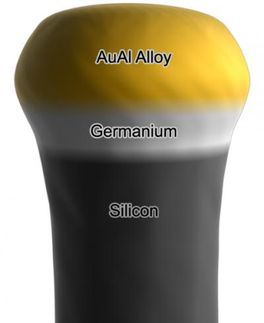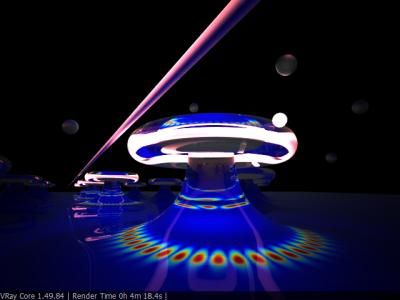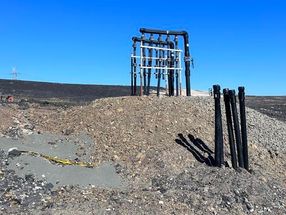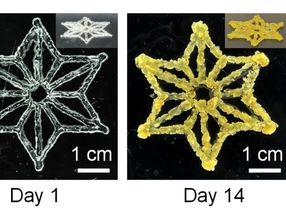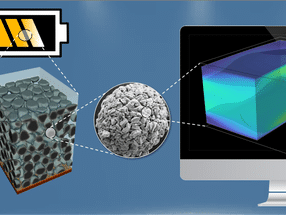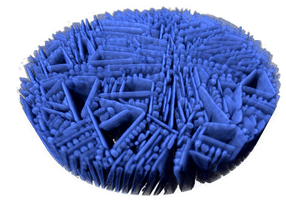Nanocrystals Are Hot
Germanium Nanocrystals Embedded in Glass: They're Hotter Before They Melt and Colder Before They Freeze
Scientists at the Department of Energy's Lawrence Berkeley National Laboratory have discovered that nanocrystals of germanium embedded in silica glass don't melt until the temperature rises almost 200 degrees Kelvin above the melting temperature of germanium in bulk. What's even more surprising, these melted nanocrystals have to be cooled more than 200 K below the bulk melting point before they resolidify. Such a large and nearly symmetrical "hysteresis" - the divergence of melting and freezing temperatures above and below the bulk melting point - has never before been observed for embedded nanoparticles.
To exploit these properties means understanding the melting/freezing transition of germanium under a variety of conditions. The researchers embedded nanoparticles averaging 2.5 nanometers in diameter in silica. What they encountered when they heated and cooled this system was completely unexpected.
For almost a hundred years, theorists and experimenters have studied how the size of a crystal affects melting and freezing, the transition between the liquid and solid state of a material. For most crystalline materials, the smaller the size, the lower the melting temperature. The melting temperature of a free-standing metal or semiconductor nanocrystal, typically comprised of a few hundred to a few thousand atoms, may be more than 300 degrees Kelvin below the melting temperature of the same material in bulk.
The reason for this, says Joel Ager of MSD, a coauthor of the Physical Review Letters report, is that "the smaller a solid object gets, the larger the percentage of its atoms residing at the surface. If it keeps shrinking, eventually it's practically all surface." Inside a crystalline solid the atoms are constrained by the crystal lattice, "but at the surface the atoms have more freedom to move. As the temperature increases, they begin to vibrate; when the vibration of the surface atoms reaches a certain percentage of the bond length between them, melting begins and then starts to propagate through the solid."
"Melting and freezing begin at the interface between the surface of the solid and its surroundings," says theorist Daryl Chrzan of MSD, also a professor of materials science at UC Berkeley. "The solid phase has a certain free energy, the liquid another, vapor yet another, and interfaces between these phases have their own characteristic energies. The likelihood of a phase transition occurring in one direction or the other can be calculated based on the free energies of the material phases themselves and their interface energies, taking into account volume, geometry, density, and other factors."
For most materials, interface energies between solid and vapor - for example, a bar of gold in air - favor the formation of a liquid surface layer as the temperature increases, which continues to grow until the entire object is melted; this liquid layer forms more readily at lower temperatures as the proportion of surface to volume increases. Eugene Haller of Berkeley Lab's Materials Sciences Division (MSD), who is also a professor of materials science at the University of California at Berkeley notes that "if you make free-standing nanoparticles of gold small enough, they melt at room temperature."
Embedded nanocrystals occasionally behave differently, however. Superheating has been observed in the case of nanocrystals embedded in a crystalline matrix, for example nanoparticles of lead embedded in an aluminum matrix. This is attributed to the lattice structures of the two crystals "locking up," suppressing the vibration of the nanoparticles' surface atoms that would lead to melting.
But germanium nanocrystals in silica glass are quite a different matter: the glass matrix has no lattice structure to lock with the surface of the germanium crystal. Ager says that "because there was no lattice structure in the matrix, we had naively expected the germanium crystals to behave more like free-standing nanoparticles - that is, we expected the melting temperature to be much less than in bulk germanium. Instead, to our surprise, germanium nanocrystals in glass had to be superheated to melt."
That was only the first surprise. In bulk materials, the interface energy between solid and vapor, which allows the transition from solid to liquid at the melting temperature, creates a roadblock in the opposite direction, an energy barrier to freezing.
"It always costs energy to form a surface," says Chrzan. "In the bulk, in fact, it's possible to supercool many materials and maintain them in a liquid state well above their normal freezing/melting point. In order to freeze, a material must overcome that slight energy barrier so as to form a critical solid nucleus."
In the case of germanium nanocrystals embedded in glass, the same large interface-energy barrier that leads to superheating before the solid crystal can melt means the melted inclusions must be supercooled before they freeze.
Original publication: Q. Xu, I. D. Sharp, C. W. Yuan, D. O. Yi, C. Y. Liao, A. M. Glaeser, A. M. Minor, J. W. Beeman, M. C. Ridgway, P. Kluth, J. W. Ager III, D. C. Chrzan, E. E. Haller; "Large melting point hysteresis of Ge nanocrystals embedded in SiO2"; Physical Review Letters 2006.
